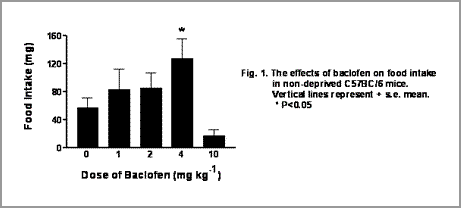Effects of GABAB receptor agonist baclofen on food intake in the mouse It has previously been demonstrated that systemic administration of the GABAB receptor agonist baclofen increases food consumption in non-deprived rats (Ebenezer et al., 1992), and more recently, it has been shown that endogenous central GABA, acting at GABAB receptors, plays a physiological role in the regulation of food intake (Patel et al., 2004). The aim of the present study was to investigate the effects of systemic administration of baclofen in another animal species, namely, the mouse. This was considered important for the following reasons: (i) such a study would indicate whether systemic administration of baclofen would have similar effects on food consumption in another animal species, and (ii) the mouse can be genetically manipulated, which would make it possible to further investigate the role use GABAB receptors in the regulation of food intake using molecular biological techniques. Male C57BC/6 mice (n=8; b. wt. 29 – 32 g) were housed in a single cage and had free access to food and water at all times. The mice were given four 120 min training session during which they were placed singly in experimental cages with free access to a weighed pellet of food and water. During experimental trials, the mice were injected i.p. with either saline or baclofen (1, 2, 4 or 10 mg kg-1) in a repeated measures design and cumulative food intake measured at 60 min. At least 2 days separated successive trials. The data was analysed by ANOVA. The results are illustrated in Fig. 1 and show that low i.p. doses of baclofen in the range 1 to 4 mg kg-1 caused a dose-dependent increase in food intake in the mice. Analysis of the data showed significant main effects of treatment (F = 5.700, P<0.01). Post-hoc Dunnett’s Multiple Comparison test revealed that only the 4 mg kg-1 dose of baclofen significantly increased food consumption in the animals. The 1 and 2 mg kg-1 doses were without significant effects. On the other hand, the 10 mg kg-1 dose caused the animals to display signs of mild ataxia and drowsiness and this was probably reflected in the non-significant decrease in mean food consumption observed (see Fig. 1). It is noteworthy that the hyperphagic effects of the lower doses of baclofen (i.e. 1 – 4 mg kg-1) were not as pronounced in mouse compared with rat (see Ebenezer et al., 1992, 2004). It is possible that this may be due to species differences. Nevertheless, the results indicate that low doses of the GABAB receptor agonist baclofen produces similar effects on food intake in two different rodent species.
Ebenezer, I.S. et al. (1992) Neuropharmacol., 31, 39 – 42. |
|


